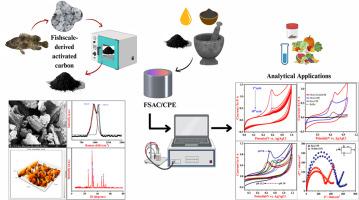鱼鳞活性炭修饰电极对环境样品和个人护理用品中三氯生的灵敏检测
IF 3.8
Q2 BIOTECHNOLOGY & APPLIED MICROBIOLOGY
引用次数: 0
摘要
三氯生(TCS)是一种用于抗菌的化合物,最近被认为是一种可以破坏内分泌功能的环境污染物。目前,研究生物和环境样品中TCS的存在是一个值得关注的问题。本研究旨在建立一种新型传感器,用于在十六烷基三甲基溴化铵(CTAB)存在下,以鱼鳞(FS)为基础的活性炭改性碳膏(AC)检测和定量分析TCS。调查包括使用pH为9.0的磷酸盐缓冲盐水(PBS)溶液对TCS污染的水果、蔬菜、土壤、水和卫生用品进行评估。与碳糊电极(CPE)相比,该传感器具有更高的氧化电流响应。采用循环伏安法和方波伏安法研究了TCS的电化学性能。用电化学阻抗谱法对制备的裸片和FSAC/CTAB/CPE进行了表征。分析了合成的FSAC的结构特征、结晶度和形貌。在最佳条件下,TCS在5 μM - 20 μM范围内呈良好的线性关系,检出限为4.8 nM。在果汁、蔬菜、水和卫生用品中添加浓度为5、7、9 μM的TCS,回收率为93.9% ~ 108.0%。结合CTAB, FSAC/CPE体系具有良好的灵敏度和选择性。这项工作证明了利用FSAC开发电化学传感平台的可能性,该平台在食品安全和环境监测方面具有很大的潜力。本文章由计算机程序翻译,如有差异,请以英文原文为准。

Sensitive detection of triclosan in environmental samples and personal care products using fish scale-derived activated carbon modified electrode
Triclosan (TCS), a compound used for its antibacterial properties, has recently been recognized as an environmental contaminant that can disrupt endocrine function. Currently, research into the presence of TCS in biological and environmental samples is a significant concern. This research aims to build a novel sensor to detect and quantitatively analyze TCS with carbon paste modified with activated carbon (AC) based on fish scales (FS) in the presence of cetyltrimethylammonium bromide (CTAB). The investigation included the assessment of TCS contaminated fruits, vegetables, soil, water, and hygiene products using a phosphate buffer saline (PBS) solution with a pH of 9.0. The proposed sensor resulted in higher oxidation currents response of TCS compared to a carbon paste electrode (CPE). The electrochemical properties of TCS were investigated cyclic voltammetry and square wave voltammetry. The fabricated bare and FSAC/CTAB/CPE was characterized by electrochemical impedance spectroscopy. The structural characteristics, crystallinity, and morphology of the synthesized FSAC were analyzed. In the optimum conditions, a linear relationship was obtained in the range of 5 μM–20 μM TCS, and the detection limit was 4.8 nM. The recovery results obtained with 5, 7, and 9 μM of spiked concentrations of TCS in fruit juice, vegetables, water, and hygiene products ranged from 93.9 % to 108.0 %. With the integration of CTAB, the FSAC/CPE system showed good sensitivity and selectivity. This work demonstrates the possibility of exploiting FSAC for developing electrochemical sensing platforms, which have great potential in food safety and environmental monitoring.
求助全文
通过发布文献求助,成功后即可免费获取论文全文。
去求助
来源期刊

Biocatalysis and agricultural biotechnology
Agricultural and Biological Sciences-Agronomy and Crop Science
CiteScore
7.70
自引率
2.50%
发文量
308
审稿时长
48 days
期刊介绍:
Biocatalysis and Agricultural Biotechnology is the official journal of the International Society of Biocatalysis and Agricultural Biotechnology (ISBAB). The journal publishes high quality articles especially in the science and technology of biocatalysis, bioprocesses, agricultural biotechnology, biomedical biotechnology, and, if appropriate, from other related areas of biotechnology. The journal will publish peer-reviewed basic and applied research papers, authoritative reviews, and feature articles. The scope of the journal encompasses the research, industrial, and commercial aspects of biotechnology, including the areas of: biocatalysis; bioprocesses; food and agriculture; genetic engineering; molecular biology; healthcare and pharmaceuticals; biofuels; genomics; nanotechnology; environment and biodiversity; and bioremediation.
 求助内容:
求助内容: 应助结果提醒方式:
应助结果提醒方式:


